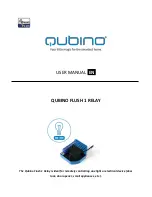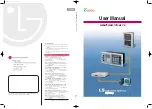
6
Connections
The three phase-currents of the overcurrent pro-
tection are connected to terminals 1-2, 4-5 and
7-8, when the rated current of the secondary
circuits is I
n
= 5 A. When using current trans-
formers with a rated current of 1 A, terminals
1-3, 4-6 and 7-9 are used. The overcurrent pro-
tection may also be used in single-phase or two-
phase applications, in which case inputs not to
be used are left unconnected. In single-phase
applications, however, wiring the phase current
through two current inputs in series may in-
crease the operating speed of the relay, particu-
larly for instantaneous operations.
The neutral current of the earth-fault protec-
tion is connected to terminals 25-27 when the
rated current is 1 A and to terminals 25-28 when
the rated current is 0.2 A.
The control input 10-11 can be used in three
different ways, as the control input of an exter-
nal blocking signal for the measuring modules,
as the control input for unlatching the trip relay,
or as the control input for the remote control
of settings. The function is selected by means
of switches 1...8 of switchgroup SGB in the
main menu of the measuring relay module.
The auxiliary supply voltage of the relay is con-
nected to the terminals 61-62. At d.c. auxiliary
supply voltage the positive lead is connected to
terminal 61. The level of the voltage to be ap-
plied to the terminals is determined by the type
of power supply and output relay module in-
serted in the protection. For further details see
the description of the power supply module. The
auxiliary voltage range of the relay has been
marked on the front panel.
Output relay A provides the CB tripping com-
mands so that the CB operates once the operat-
ing time of the low-set or high-set stage of the
overcurrent or non-directional earth-fault mod-
ule has elapsed. The stages to perform a trip-
ping are selected with switches 2,4,6 and 8 of
switchgroup SGR1. On delivery from factory
all stages are selected to perform tripping. A
latching function of the output relay A can be
selected by means of switches SGB 6 and 7 for
overcurrent and earth-fault trippings.
The trip alarm signals from the measuring mod-
ules are obtained through output relays B and
C. The signals to be forwarded to the output
relays B and C are selected with switches1...8
of switchgroup SGR2 of the measuring mod-
ule. The switch matrixes for configuration of
the control signals of the output relays B and C
identical. Normally the output relays B and C
are given such a configuration that low-set and
high-set overcurrent trip alarm signal is obtained
over relay C and the corresponding alarm sig-
nal for the earth-fault trips via output relay B.
This is also the default setting on delivery.
The starting signals from the protective stages
of the relay are received through output relay
D. The signals to be forwarded to the output
relay D are selected by means of switches 1, 3, 5
and 7 of switchgroup SGR1 which is found in
the main menu of the measuring module. The
starting signals of the low-set and high-set stage
of the overcurrent unit are selected with switches
1 and 3, whereas switches 5 and 7 convey the
corresponding signals of the non-directional
earth-fault unit.
Output relay E, terminals 74-75, is a heavy duty
output relay capable of controlling a circuit
breaker, like the main trip relay A. Relay E is
used mainly for bringing out any starting or time
delayed signal for starting of auto-reclosures, for
signalling or counting purposes or for auxiliary
trip. Output relay E is also used as a tripping
output for the circuit breaker failure protection,
CBFP when the CBFP function is used. In this
case the trip signal can be used either to con-
trol a circuit breaker upstreams or to control a
second trip coil on the main circuit breaker to
give a higher redundancy to the breaker opera-
tion.
Output relay F, terminals 70-71-72, operates as
the output relay of the self-supervision system
of the relay. The relay operates on the closed-
circuit principle so that in normal service con-
ditions the contact gap 70-72 is closed. If a fault
is detected by the self-supervision system, or if
there is a failure in the auxiliary supply, the out-
put relay drops off providing an alarm signal by
closing the NO contact 71-72.
The relay is interfaced with a data transmission
bus through a 9-pole, D-type subminiature con-
nector located at the rear panel of the relay. By
means of bus connection modules SPA-ZC 17
or SPA-ZC 21 the overcurrent and earth-fault
relay can be linked to the fibre-optic bus. The
terminals of the fibre-optic cables are connected
to the counter terminals Rx and Tx of the bus
connection module. The fibre-optic cables are
linked from one protection to another and to
the substation level communication, for instance
type SRIO 1000M.




































